2008 MERCEDES-BENZ CLS COUPE child restraint
[x] Cancel search: child restraintPage 53 of 329
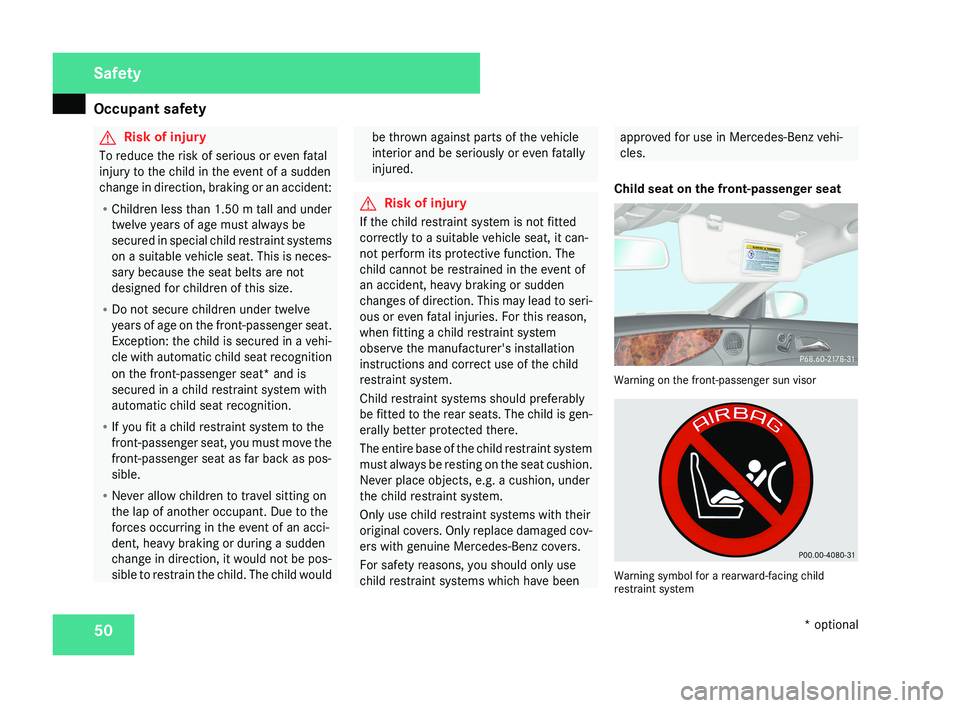
Occupant safety
50 G
Risk of injury
To reduce the risk of serious or even fatal
injury to the child in the event of a sudden
change in direction, braking or an accident:
R Children less than 1.50 m tall and under
twelve years of age must always be
secured in special child restraint systems
on a suitable vehicle seat. This is neces-
sary because the seat belts are not
designed for children of this size.
R Do not secure children under twelve
years of age on the front-passenger seat.
Exception: the child is secured in a vehi-
cle with automatic child seat recognition
on the front-passenger seat* and is
secured in a child restraint system with
automatic child seat recognition.
R If you fit a child restraint system to the
front-passenger seat, you must move the
front-passenger seat as far back as pos-
sible.
R Never allow children to travel sitting on
the lap of another occupant. Due to the
forces occurring in the event of an acci-
dent, heavy braking or during a sudden
change in direction, it would not be pos-
sible to restrain the child. The child would be thrown against parts of the vehicle
interior and be seriously or even fatally
injured.
G
Risk of injury
If the child restraint system is not fitted
correctly to a suitable vehicle seat, it can-
not perform its protective function. The
child cannot be restrained in the event of
an accident, heavy braking or sudden
changes of direction. This may lead to seri-
ous or even fatal injuries. For this reason,
when fitting a child restraint system
observe the manufacturer's installation
instructions and correct use of the child
restraint system.
Child restraint systems should preferably
be fitted to the rear seats. The child is gen-
erally better protected there.
The entire base of the child restraint system
must always be resting on the seat cushion.
Never place objects, e.g. a cushion, under
the child restraint system.
Only use child restraint systems with their
original covers. Only replace damaged cov-
ers with genuine Mercedes-Benz covers.
For safety reasons, you should only use
child restraint systems which have been approved for use in Mercedes-Benz vehi-
cles.
Child seat on the front-passenger seatWarning on the front-passenger sun visor
Warning symbol for a rearward-facing child
restraint system
Safety
* optional
219_AKB; 2; 4, en-GB
mkalafa,
2007-11-13T09:28:36+01:00 - Seite 50
Page 54 of 329
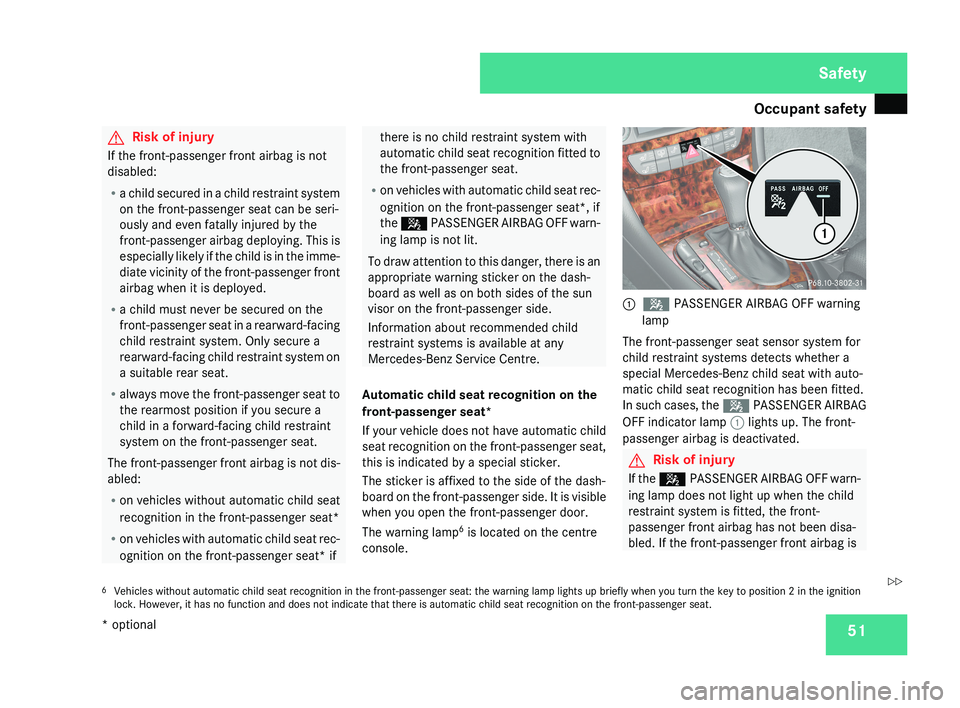
Occupant safety
51G
Risk of injury
If the front-passenger front airbag is not
disabled:
R a child secured in a child restraint system
on the front-passenger seat can be seri-
ously and even fatally injured by the
front-passenger airbag deploying. This is
especially likely if the child is in the imme-
diate vicinity of the front-passenger front
airbag when it is deployed.
R a child must never be secured on the
front-passenger seat in a rearward-facing
child restraint system. Only secure a
rearward-facing child restraint system on
a suitable rear seat.
R always move the front-passenger seat to
the rearmost position if you secure a
child in a forward-facing child restraint
system on the front-passenger seat.
The front-passenger front airbag is not dis-
abled:
R on vehicles without automatic child seat
recognition in the front-passenger seat*
R on vehicles with automatic child seat rec-
ognition on the front-passenger seat* if there is no child restraint system with
automatic child seat recognition fitted to
the front-passenger seat.
R on vehicles with automatic child seat rec-
ognition on the front-passenger seat*, if
the 5 PASSENGER AIRBAG OFF warn-
ing lamp is not lit.
To draw attention to this danger, there is an
appropriate warning sticker on the dash-
board as well as on both sides of the sun
visor on the front-passenger side.
Information about recommended child
restraint systems is available at any
Mercedes-Benz Service Centre.
Automatic child seat recognition on the
front-passenger seat*
If your vehicle does not have automatic child
seat recognition on the front-passenger seat,
this is indicated by a special sticker.
The sticker is affixed to the side of the dash-
board on the front-passenger side. It is visible
when you open the front-passenger door.
The warning lamp 6
is located on the centre
console.1 5 PASSENGER AIRBAG OFF warning
lamp
The front-passenger seat sensor system for
child restraint systems detects whether a
special Mercedes-Benz child seat with auto-
matic child seat recognition has been fitted.
In such cases, the 5 PASSENGER AIRBAG
OFF indicator lamp 1 lights up. The front-
passenger airbag is deactivated.
G Risk of injury
If the 5 PASSENGER AIRBAG OFF warn-
ing lamp does not light up when the child
restraint system is fitted, the front-
passenger front airbag has not been disa-
bled. If the front-passenger front airbag is
6 Vehicles without automatic child seat recognition in the front-passenger seat: the warning lamp lights up briefly when you turn the key to position 2 in the ignition
lock. However, it has no function and does not indicate that there is automatic child seat recognition on the front-passenger seat.
Safety
* optional
219_AKB; 2; 4, en-GB
mkalafa,
2007-11-13T09:28:36+01:00 - Seite 51
Z
Page 55 of 329
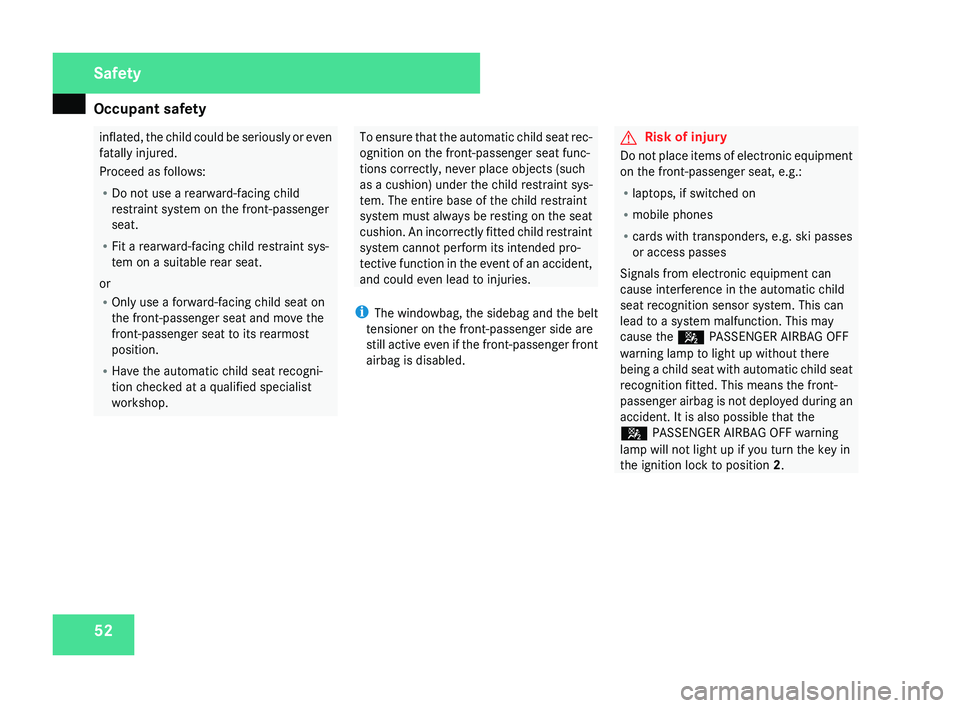
Occupant safety
52 inflated, the child could be seriously or even
fatally injured.
Proceed as follows:
R
Do not use a rearward-facing child
restraint system on the front-passenger
seat.
R Fit a rearward-facing child restraint sys-
tem on a suitable rear seat.
or
R Only use a forward-facing child seat on
the front-passenger seat and move the
front-passenger seat to its rearmost
position.
R Have the automatic child seat recogni-
tion checked at a qualified specialist
workshop. To ensure that the automatic child seat rec-
ognition on the front-passenger seat func-
tions correctly, never place objects (such
as a cushion) under the child restraint sys-
tem. The entire base of the child restraint
system
must always be resting on the seat
cushion. An incorrectly fitted child restraint
system cannot perform its intended pro-
tective function in the event of an accident,
and could even lead to injuries.
i The windowbag, the sidebag and the belt
tensioner on the front-passenger side are
still active even if the front-passenger front
airbag is disabled. G
Risk of injury
Do not place items of electronic equipment
on the front-passenger seat, e.g.:
R laptops, if switched on
R mobile phones
R cards with transponders, e.g. ski passes
or access passes
Signals from electronic equipment can
cause interference in the automatic child
seat recognition sensor system. This can
lead to a system malfunction. This may
cause the 5 PASSENGER AIRBAG OFF
warning lamp to light up without there
being
a child seat with automatic child seat
recognition fitted. This means the front-
passenger airbag is not deployed during an
accident. It is also possible that the
5 PASSENGER AIRBAG OFF warning
lamp will not light up if you turn the key in
the ignition lock to position 2.Safety
219_AKB; 2; 4, en-GB
mkalafa,
2007-11-13T09:28:36+01:00 - Seite 52
Page 56 of 329
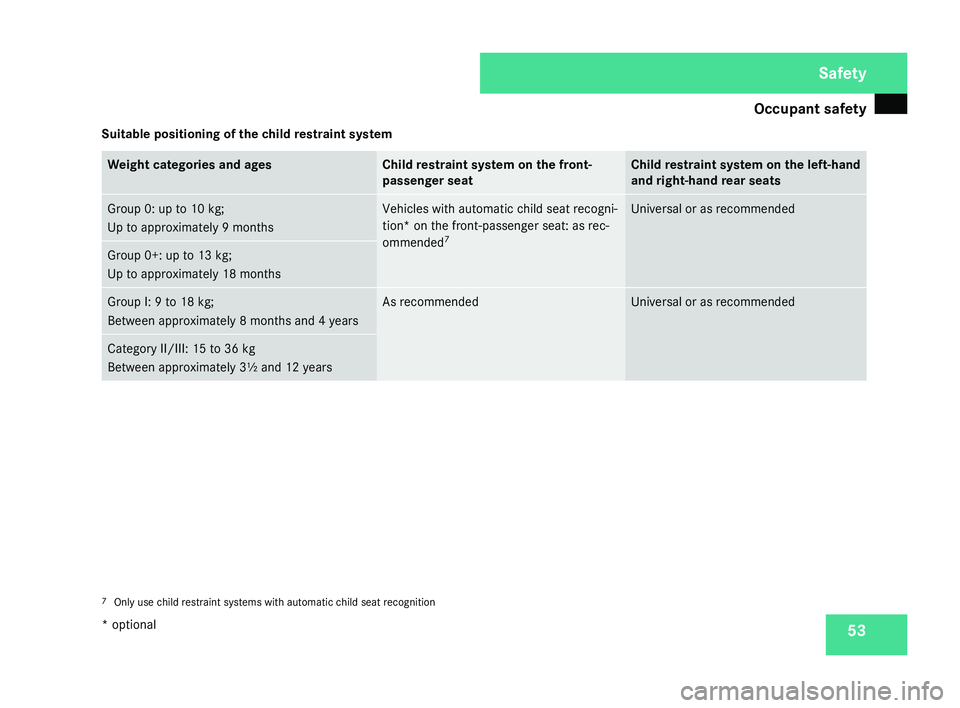
Occupant safety
53
Suitable positioning of the child restraint system Weight categories and ages Child restraint system on the front-
passenger seat Child restraint system on the left-hand
and right-hand rear seats
Group 0: up to 10 kg;
Up to approximately 9 months Vehicles with automatic child seat recogni-
tion* on the front-passenger seat: as rec-
ommended
7 Universal or as recommended
Group 0+: up to 13 kg;
Up to approximately 18 months
Group I: 9 to 18 kg;
Between approximately 8 months and 4 years As recommended Universal or as recommended
Category II/III: 15 to 36 kg
Between approximately 3½ and 12 years
7
Only use child restraint systems with automatic child seat recognition Safety
* optional
219_AKB; 2; 4, en-GB
mkalafa,
2007-11-13T09:28:36+01:00 - Seite 53
Page 57 of 329
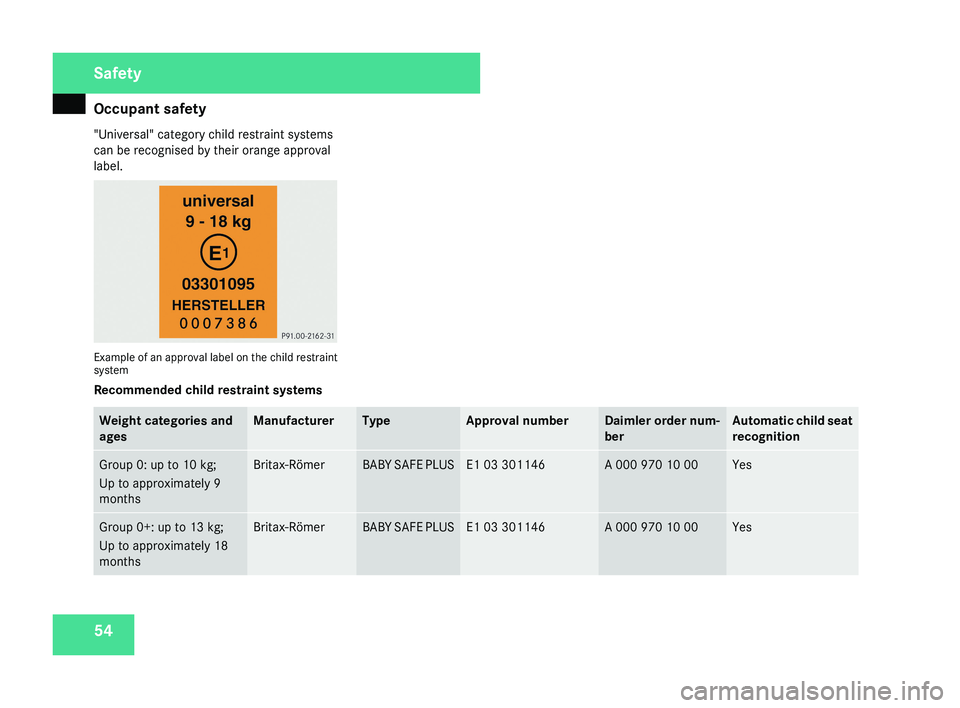
Occupant safety
54
"Universal" category child restraint systems
can be recognised by their orange approval
label.Example of an approval label on the child restraint
system
Recommended child restraint systems
Weight categories and
agesManufacturerTypeApproval numberDaimler order num-
berAutomatic child seat
recognition
Group 0: up to 10 kg;
Up to approximately 9
monthsBritax-RömerBABY SAFE PLUSE1 03 301146A 000 970 10 00Yes
Group 0+: up to 13 kg;
Up to approximately 18
monthsBritax-RömerBABY SAFE PLUSE1 03 301146A 000 970 10 00Yes
Safety
219_AKB; 2; 4, en-GB
mkalafa,
2007-11-13T09:28:36+01:00 - Seite 54
Page 58 of 329
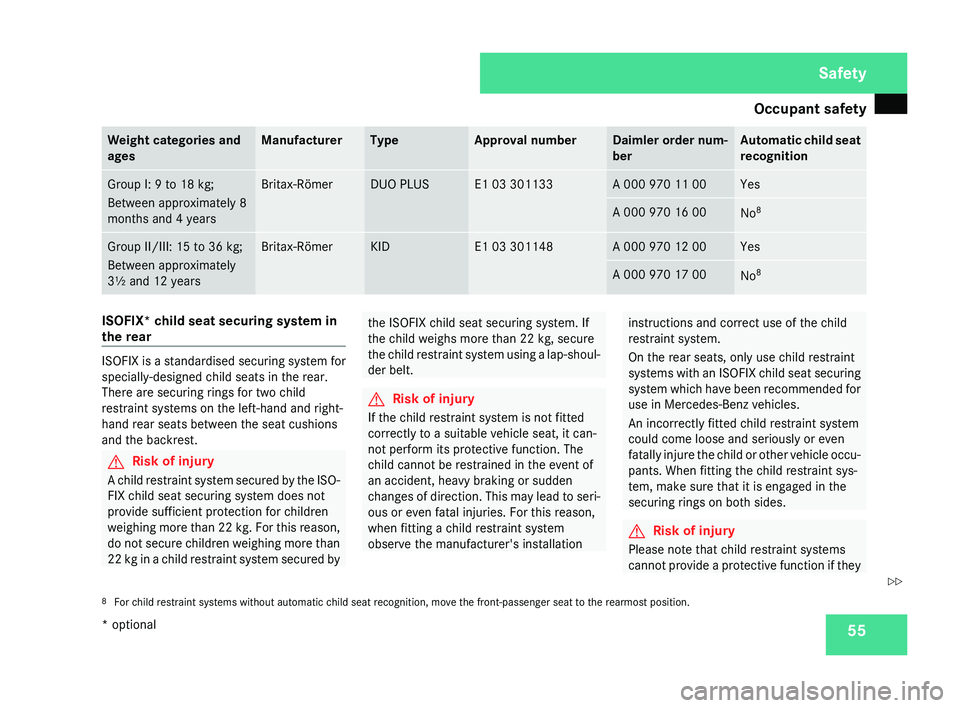
Occupant safety
55Weight categories and
ages Manufacturer Type Approval number Daimler order num-
ber Automatic child seat
recognition
Group I: 9 to 18 kg;
Between approximately 8
months and 4 years Britax-Römer DUO PLUS E1 03 301133 A 000 970 11 00 Yes
A 000 970 16 00
No
8 Group II/III: 15 to 36 kg;
Between approximately
3½ and 12 years Britax-Römer KID E1 03 301148 A 000 970 12 00 Yes
A 000 970 17 00
No
8 ISOFIX* child seat securing system in
the rear
ISOFIX is a standardised securing system for
specially-designed child seats in the rear.
There are securing rings for two child
restraint systems on the left-hand and right-
hand rear seats between the seat cushions
and the backrest.
G
Risk of injury
A child restraint system secured by the ISO-
FIX child seat securing system does not
provide sufficient protection for children
weighing
more than 22 kg. For this reason,
do not secure children weighing more than
22 kg in a child restraint system secured by the ISOFIX child seat securing system. If
the child weighs more than 22 kg, secure
the
child restraint system using a lap-shoul-
der belt. G
Risk of injury
If the child restraint system is not fitted
correctly to a suitable vehicle seat, it can-
not perform its protective function. The
child cannot be restrained in the event of
an accident, heavy braking or sudden
changes
of direction. This may lead to seri-
ous or even fatal injuries. For this reason,
when fitting a child restraint system
observe the manufacturer's installation instructions and correct use of the child
restraint system.
On the rear seats, only use child restraint
systems
with an ISOFIX child seat securing
system which have been recommended for
use in Mercedes-Benz vehicles.
An incorrectly fitted child restraint system
could come loose and seriously or even
fatally injure the child or other vehicle occu-
pants. When fitting the child restraint sys-
tem, make sure that it is engaged in the
securing rings on both sides. G
Risk of injury
Please note that child restraint systems
cannot
provide a protective function if they
8 For child restraint systems without automatic child seat recognition, move the front-passenger seat to the rearmost position. Safety
* optional
219_AKB; 2; 4, en-GB
mkalafa,
2007-11-13T09:28:36+01:00 - Seite 55 Z
Page 59 of 329
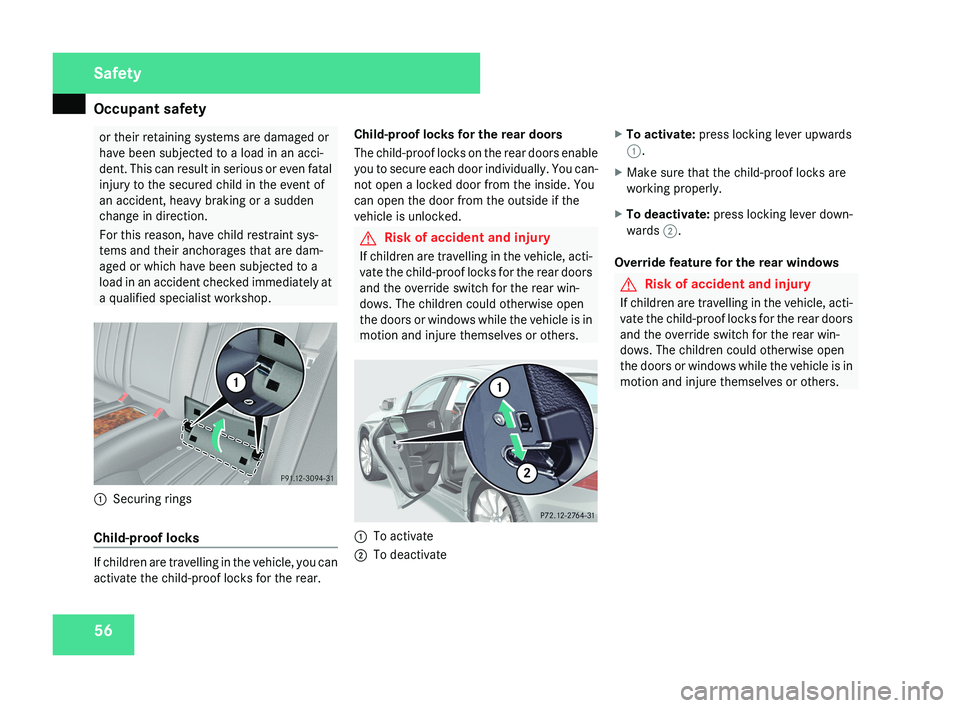
Occupant safety
56 or their retaining systems are damaged or
have been subjected to a load in an acci-
dent. This can result in serious or even fatal
injury to the secured child in the event of
an accident, heavy braking or a sudden
change in direction.
For this reason, have child restraint sys-
tems and their anchorages that are dam-
aged or which have been subjected to a
load in an accident checked immediately at
a qualified specialist workshop.1
Securing rings
Child-proof locks
If children are travelling in the vehicle, you can
activate the child-proof locks for the rear. Child-proof locks for the rear doors
The child-proof locks on the rear doors enable
you to secure each door individually. You can-
not open a locked door from the inside. You
can open the door from the outside if the
vehicle is unlocked.
G
Risk of accident and injury
If children are travelling in the vehicle, acti-
vate the child-proof locks for the rear doors
and the override switch for the rear win-
dows. The children could otherwise open
the doors or windows while the vehicle is in
motion and injure themselves or others.
1 To activate
2 To deactivate X
To activate: press locking lever upwards
1.
X Make sure that the child-proof locks are
working properly.
X To deactivate: press locking lever down-
wards 2.
Override feature for the rear windows
G Risk of accident and injury
If children are travelling in the vehicle, acti-
vate the child-proof locks for the rear doors
and the override switch for the rear win-
dows. The children could otherwise open
the doors or windows while the vehicle is in
motion and injure themselves or others.
Safety
219_AKB; 2; 4, en-GB
mkalafa,
2007-11-13T09:28:36+01:00 - Seite 56
Page 78 of 329
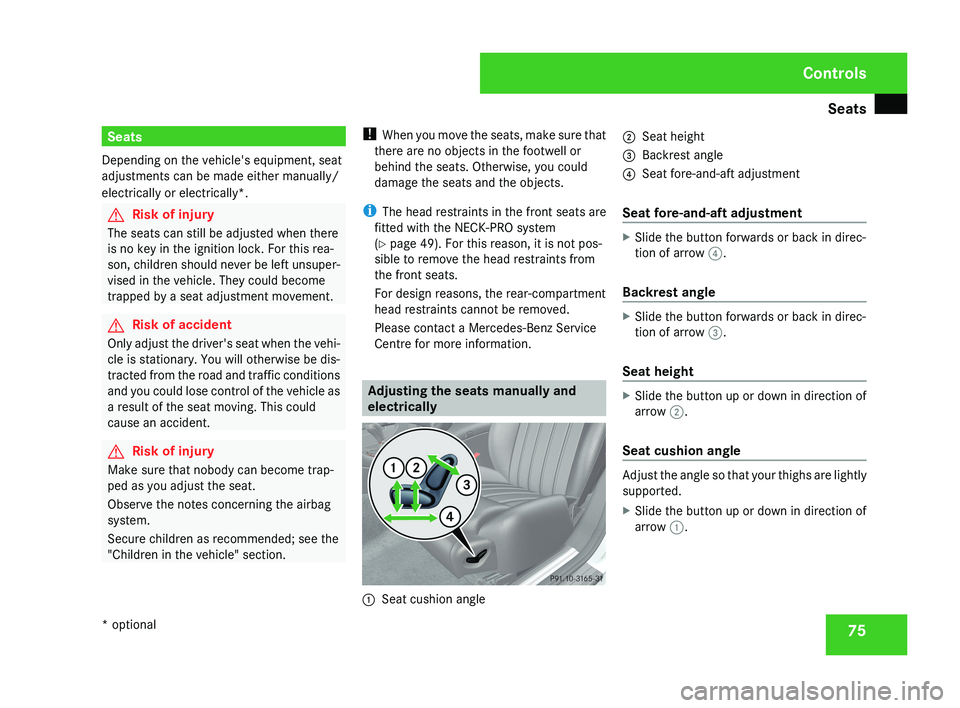
Seats
75Seats
Depending on the vehicle's equipment, seat
adjustments can be made either manually/
electrically or electrically*. G
Risk of injury
The seats can still be adjusted when there
is no key in the ignition lock. For this rea-
son, children should never be left unsuper-
vised in the vehicle. They could become
trapped by a seat adjustment movement. G
Risk of accident
Only adjust the driver's seat when the vehi-
cle is stationary. You will otherwise be dis-
tracted from the road and traffic conditions
and you could lose control of the vehicle as
a result of the seat moving. This could
cause an accident. G
Risk of injury
Make sure that nobody can become trap-
ped as you adjust the seat.
Observe the notes concerning the airbag
system.
Secure children as recommended; see the
"Children in the vehicle" section. !
When you move the seats, make sure that
there are no objects in the footwell or
behind the seats. Otherwise, you could
damage the seats and the objects.
i The head restraints in the front seats are
fitted with the NECK-PRO system
(Y page 49). For this reason, it is not pos-
sible to remove the head restraints from
the front seats.
For design reasons, the rear-compartment
head restraints cannot be removed.
Please contact a Mercedes-Benz Service
Centre for more information. Adjusting the seats manually and
electrically1
Seat cushion angle 2
Seat height
3 Backrest angle
4 Seat fore-and-aft adjustment
Seat fore-and-aft adjustment
X Slide the button forwards or back in direc-
tion of arrow 4.
Backrest angle
X Slide the button forwards or back in direc-
tion of arrow 3.
Seat height
X Slide the button up or down in direction of
arrow 2.
Seat cushion angle
Adjust the angle so that your thighs are lightly
supported.
X Slide the button up or down in direction of
arrow 1.
Controls
* optional
219_AKB; 2; 4, en-GB
mkalafa,
2007-11-13T09:28:36+01:00 - Seite 75